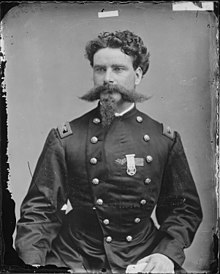Percy Wyndham (soldier)
Percy Wyndham | |
|---|---|
 Wyndham during the American Civil War | |
| Born | 22 September 1833 The Downs, English Channel |
| Died | 27 January 1879 (1879-01-28) (aged 45) Rangoon, Burma |
| Allegiance |
|
| Service/branch | French Navy (1848–1850) British Army (1851–1852) Austrian Army (1852–1860) Garibaldi's Volunteers (1860–1861) Union Army (1862–1864) Royal Italian Army |
| Rank | |
| Commands held | 1st New Jersey Cavalry Regiment |
| Battles/wars | French Revolution of 1848 Expedition of the Thousand
American Civil War
|
| Awards | Military Order of Savoy |
| Other work | balloonist |
Colonel Percy Wyndham (22 September 1833 – 27 January 1879) was an English soldier and adventurer who served in the armed forces of several countries and saw active service during the Italian Risorgimento and the American Civil War.
Life
While in the United States, Wyndham stated that he was the son of Colonel Charles Wyndham, a regular soldier of the British Army's Fifth Light Cavalry, and had been born in 1833 on board the ship Arab in the Downs. He had begun his career at the age of fifteen, fighting in the Students' Corps during the French Revolution of 1848.[1][2] He said that in July of the same year he was commissioned into the French Navy as a "marine ensign", a form of midshipman, before briefly serving in the Royal Artillery of the British Army from 1851 to 1852. After that, he had served until 1860 as a cavalry officer in the Austrian Army's 8th Lancers Regiment, before travelling to Italy to serve under Garibaldi. Wyndham said he had fought with Garibaldi at Palermo, Nuloggo, Rager, and Capua, at the last of which he had been promoted lieutenant-colonel, given command of a brigade, and knighted by King Victor Emmanuel, who had appointed him a knight of the Military Order of Savoy; and that was why he sometimes used the title of "Sir" in English. He had continued to command a brigade until on 8 October 1861, following the outbreak of the American Civil War, he had been given leave to enable him to offer his services to the Union.[1][3]
Whatever his origins, Wyndham undoubtedly travelled to North America and served in the Union Army during the Civil War. Taken prisoner by Confederate forces on 6 June 1862, he was exchanged for prisoners of the Confederacy only a few weeks later,[3] and in August 1862 commanded the 1st New Jersey Cavalry Regiment at the Battle of Thoroughfare Gap.[4] On 9 June 1863 Wyndham was wounded at the Battle of Brandy Station, and thereafter he served in Washington, D. C. While there, his namesake the English politician Percy S. Wyndham accused him of being a fraud, prompting Wyndham to give an account of his career, supported by documentary evidence.[5] His pointed reply to the other Wyndham included the statement that
.mw-parser-output .templatequote{overflow:hidden;margin:1em 0;padding:0 40px}.mw-parser-output .templatequote .templatequotecite{line-height:1.5em;text-align:left;padding-left:1.6em;margin-top:0}
Some men make a name for themselves; others die contemplating the parents who gave them their name.[5]
Wyndham applied for promotion to Brigadier, with a recommendation from Major-General Joseph Hooker, who said of him "I found him capable, prompt, and efficient... and with an enemy in his front, enterprising and brave". However, he was refused the promotion, after a fellow officer had accused him of disloyalty and of considering transferring to the Confederate Army. Wyndham continued to draw his army pay until he retired from the Union's service on 5 July 1864.[5] According to some accounts, he next commanded a military school for boys.[3]
In 1866, Wyndham returned to Italy to continue his military service in the Royal Italian Army. That completed, after several failed business ventures he journeyed to India[3] where, after selling his military decorations to support himself, he took to giving hot air ballooning demonstrations to earn a living. On 27 January 1879 he was killed when his balloon burst open and fell from a height of about three hundred feet into a lake near Rangoon, Burma.[1] A newspaper there reported his death, concluding "Thus ended a singular and adventurous career".[5]
Notes
^ abc Samuel Toombs, New Jersey Troops in the Gettysburg Campaign from June 5 to July 31, 1863 (Orange, N. J.: The Evening Mail Publishing House, 1888), pp. 402–406
^ Jedediah Hotchkiss, Archie P. McDonald, Make Me a Map of the Valley: The Civil War Journal of Stonewall Jackson's Topographer (Southern Methodist University Press, 1973), p. 282 (notes)
^ abcd Robert J. Trout, Memoirs of the Stuart Horse Artillery Battalion (2008), p. 193
^ John J. Hennessy, Return to Bull Run: the Campaign and Battle of Second Manassas (New York: Simon & Schuster, 1993, .mw-parser-output cite.citation{font-style:inherit}.mw-parser-output q{quotes:"""""""'""'"}.mw-parser-output code.cs1-code{color:inherit;background:inherit;border:inherit;padding:inherit}.mw-parser-output .cs1-lock-free a{background:url("//upload.wikimedia.org/wikipedia/commons/thumb/6/65/Lock-green.svg/9px-Lock-green.svg.png")no-repeat;background-position:right .1em center}.mw-parser-output .cs1-lock-limited a,.mw-parser-output .cs1-lock-registration a{background:url("//upload.wikimedia.org/wikipedia/commons/thumb/d/d6/Lock-gray-alt-2.svg/9px-Lock-gray-alt-2.svg.png")no-repeat;background-position:right .1em center}.mw-parser-output .cs1-lock-subscription a{background:url("//upload.wikimedia.org/wikipedia/commons/thumb/a/aa/Lock-red-alt-2.svg/9px-Lock-red-alt-2.svg.png")no-repeat;background-position:right .1em center}.mw-parser-output .cs1-subscription,.mw-parser-output .cs1-registration{color:#555}.mw-parser-output .cs1-subscription span,.mw-parser-output .cs1-registration span{border-bottom:1px dotted;cursor:help}.mw-parser-output .cs1-hidden-error{display:none;font-size:100%}.mw-parser-output .cs1-visible-error{font-size:100%}.mw-parser-output .cs1-subscription,.mw-parser-output .cs1-registration,.mw-parser-output .cs1-format{font-size:95%}.mw-parser-output .cs1-kern-left,.mw-parser-output .cs1-kern-wl-left{padding-left:0.2em}.mw-parser-output .cs1-kern-right,.mw-parser-output .cs1-kern-wl-right{padding-right:0.2em}
ISBN 0-671-79368-3), pp. 153–161
^ abcd Robert F. O'Neill, Chasing Jeb Stuart and John Mosby: The Union Cavalry in Northern Virginia (2012), pp. 256–258
